| |
|
Here we are in the
Brett Valley, one of the prettiest parts of East Anglia,
I think. Nearby Lavenham and Kersey attract all the
tourists, but I wonder how many of them ever make it out
into these deliciously lovely villages that huddle in the
gentle hills between Hadleigh and Stowmarket? A mile or
so from its little sister Brent Eleigh, this village has
the grander church, but, perhaps, the less interesting
one.It certainly has a splendid setting, for this was one
of the great wool-producing villages of the Brett Valley
in late medieval days, the busiest and richest part of
England in the 15th century.
Up from the village high street, St Peter's powerful 15th
century tower can be seen for miles around, and it is a
pleasant foil to the mightily sombre St Peter and St
Paul, Lavenham, a couple of miles beyond it. St Peter's
tower is perhaps more typical of the churches of the
nearby Stour Valley, with the stair turret climbing
beyond the battlements. It certainly makes itself known -
in this hilly country, every view is like a painting.
The tower sits close to the road, with a fascinating west
doorway carved with little animals. There was a huge
rebuilding here in the late 15th century, as you might
expect. The top of the tower has deliciously decorated
flushwork and a weather vane dated 1969. The graveyard
constrains the building tightly to south and north, but
then sprawls away to the east. Looking back, you can see
that the long chancel is entirely 19th century.
You enter through the south porch. While this part of
Suffolk is well-known for some deliciously atmospheric
and historically significant interiors, this is something
different. There was an overwhelming Victorian
restoration here in the full flush of Anglican
triumphalism, leaving a fairly urban and even slightly
anonymous feeling, although this is obviously a
well-loved and cared-for place. It would have been
interesting to see this church in the 18th century, when
it was full of box pews - the door of one of them
survives in the south-west corner, labelled Free for
Women. The elegant Early English tub font on
pilasters, retaining its Perpendicular font cover has
been reset in front of the former north doorway.
The nave was rebuilt at the time of the tower, retaining
an arcade from an earlier church, but otherwise being all
of a Perpendicular piece. There is a massive set of Queen
Anne royal arms above the chancel arch, almost of a size
with those at Mildenhall. The chancel is wholly Victorian
in construction and character, but it has some
fascinating windows by the Ward & Hughes workshop,
not a sentiment I hold very often. They depict scenes
from the life of Christ - the summoning of the Disciples,
the raising of Jairus's daughter - but if you look
closely you will see that some of the figures in the
scenes have 19th century faces, and are wearing 19th
century clothes. These are memorial windows to the
figures worked into the scenes, and the brass plaques
that name them are also by Ward & Hughes.
The best one is the
astonishing consumptive figure of Jairus's daughter, who
is represented by Winifred Frances Fisher, a 17 year old
girl who was suddenly called home in 1892. Her
plaque notes that she was perfected in a short time.
She lies on her death bed, her silvery curls flowing
across the pillow in a perfect moment of late Victorian
sentiment. Rather odder is the figure of her uncle, in
full 19th Century formal wear, who peers curiously from
behind the backs of St Peter and St Andrew on their
fishing boat as they are called to the lake shore to give
their lives to Christ. Another uncle appears as Daniel
before Nebuchadnezzar, wearing period costume this time
but otherwise a fully late Victorian gentleman. Perhaps
they would take it as a compliment that they both look
rather out of place.
Simon
Knott, October 2019
Follow these journeys as they happen at Last Of England
Twitter.
  
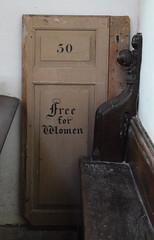 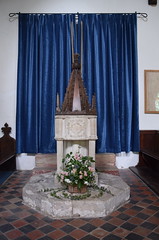  
 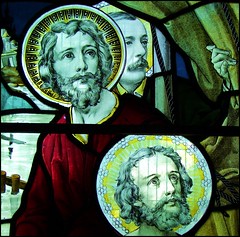 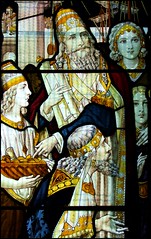 
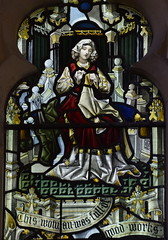   
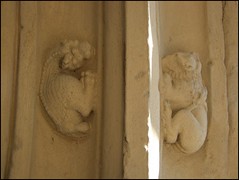  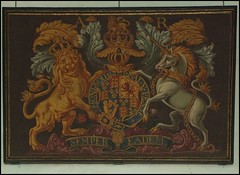
| |
| |
|
|
|
|
|
|
|
| |
|
|
|
|
|
|
|
|
The Churches of East
Anglia websites are
non-profit-making, in fact they
are run at a loss. But if you
enjoy using them and find them
useful, a small contribution
towards the costs of web space,
train fares and the like would be
most gratefully received. You can
donate via Paypal.
|
|
|
|
|
|
|
|
|
|
|
|
|
|
|
|
|
|
|
|
|
|
|
|
| |
|
|
|
|
|
|
|
|
|
|
|
|
|
|
|
|
|

